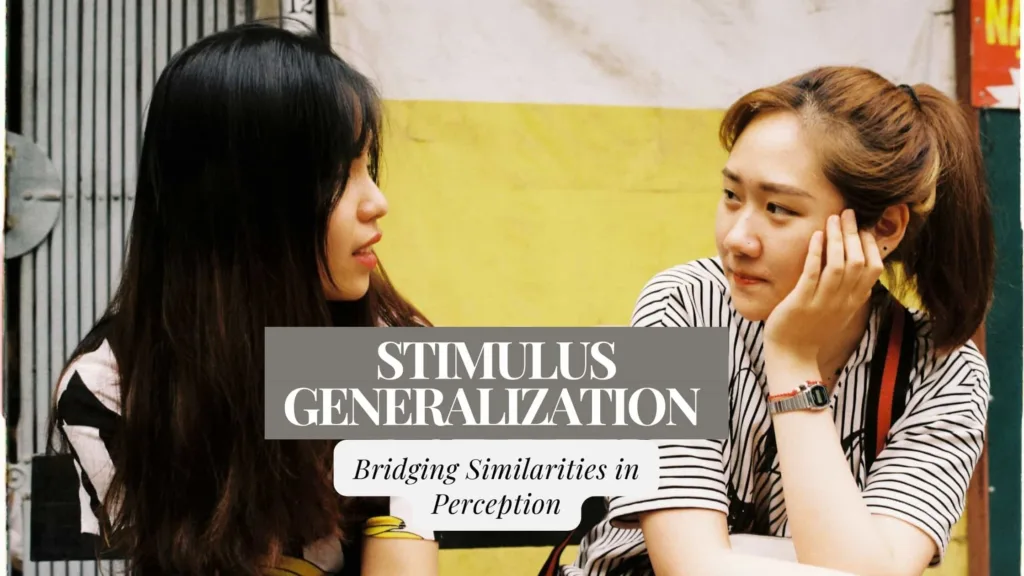Stimulus generalization is an important idea in behavioral psychology that helps explain how living beings learn and adjust to their surroundings. It means that when something is trained to respond to a specific trigger, it might also react to things that are similar, but not exactly the same. This concept helps us understand how behaviors can be carried over to different situations, giving us insight into both good and bad learning patterns.
Understanding Stimulus Generalization
Stimulus generalization happens when someone or something responds to things that are similar to what they were originally trained to respond to. For example, if a dog is trained to sit when it hears a specific command like “sit,” it might also sit when it hears words that sound similar, like “hit” or “bit.” Another example is a child who learns to fear a white rabbit after a bad experience; the child might also become afraid of other white, fluffy things like a stuffed toy or a white cat. This shows how learned behaviors can spread to other, similar situations.
Mechanisms Behind
Stimulus generalization happens through several key processes that explain why and how living beings respond to things that are similar. Understanding these processes helps us learn more about how we adapt and learn.
- Classical Conditioning: This idea comes from Ivan Pavlov. It means that an animal or person learns to connect a neutral thing, like a bell, with something important, like food. Once this connection is made, the animal might also respond to things that sound like the bell, such as a chime or a buzzer, because they are similar.
- Generalization Gradient: This concept explains how strong the response is to new things based on how similar they are to the original thing. If the new thing is very similar, the response is strong. If it is less similar, the response is weaker. The closer the new thing is to the original, the stronger the reaction will be.
- Cognitive Theories: These theories focus on how our brain categorizes and understands things. When we see something new, our brain checks if it is similar to what we already know. For example, if we learn that bees can sting and then see a wasp, we might react the same way because our brain puts bees and wasps in the same category.
- Associative Networks: This means that our brain links related ideas together. When we experience something, related experiences can trigger similar responses. For example, if a specific perfume reminds someone of a friend, smelling a similar perfume might make them feel happy, even if the friend is not there.
- Neural Mechanisms: This explanation focuses on how our brain cells (neurons) react. Neurons that respond to a specific thing can also react to similar things. This overlap in neural activation helps explain why we respond to similar things in similar ways.

Factors Influencing Stimulus Generalization
Stimulus generalization can be influenced by several factors. Here they are in simple terms:
- Similarity: The more the new thing looks or sounds like the original thing, the more likely generalization will happen. For example, if a dog learns to respond to a specific bell sound, it will also likely respond to a sound that is very similar to that bell.
- Experience and Training: The amount and type of training can change how generalization works. If someone or something has a lot of practice with a particular stimulus, they might only respond to very similar stimuli and ignore others that are less similar.
- Reinforcement Patterns: How rewards or punishments are given can affect generalization. If a reward is given every time a behavior happens, the response might generalize more broadly. If rewards are given only sometimes, the response might become more specific to certain stimuli.
- Context: Where the learning takes place can impact generalization. If a behavior is learned in one place, it might not generalize well to a very different place. For example, a behavior learned at home might not work the same way at school if the settings are very different.
- Nature of the Stimulus: Some things are more likely to generalize than others. For example, sounds might generalize more easily than complex visual patterns.
Practical Applications
Stimulus generalization is used in many practical ways. Here are some simple examples:
- Behavior Therapy: Therapists help people overcome fears by gradually exposing them to similar, non-threatening situations. For example, someone afraid of dogs might start with a small, friendly dog and then feel less afraid of other dogs too.
- Education: Teachers use it to help students apply what they learn to new situations. For example, if a student learns math with specific problems, they can also solve new, similar problems.
- Marketing: Companies use this to build brand loyalty. If you like one product from a brand, you might also like other products from the same brand because you expect them to be similar.
- Animal Training: Trainers teach animals to respond correctly in different places. For example, a dog trained to sit in the living room can also learn to sit when commanded in the park.
- Workplace Training: Employers use these ideas to train employees so that skills learned in training can be used in various tasks at work.
Related Article: Central Executive Psychology: Control center of your mind
Stimulus generalization is an important idea for understanding how we learn and behave. It shows how living beings adjust to their surroundings by applying learned reactions to new but similar things. By studying this, experts can create better ways to change behavior, teach, market products, and train animals. Even though it has its difficulties, learning about stimulus generalization helps us understand both good and bad behaviors in people and animals.

Pingback: Unconditioned Response in Psychology: Pure Reactions